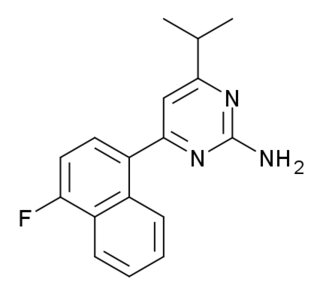
Respiratory failure results from inadequate gas exchange by the respiratory system, meaning that the arterial oxygen, carbon dioxide, or both cannot be kept at normal levels. A drop in the oxygen carried in the blood is known as hypoxemia; a rise in arterial carbon dioxide levels is called hypercapnia. Respiratory failure is classified as either Type 1 or Type 2, based on whether there is a high carbon dioxide level, and can be acute or chronic. In clinical trials, the definition of respiratory failure usually includes increased respiratory rate, abnormal blood gases, and evidence of increased work of breathing. Respiratory failure causes an altered mental status due to ischemia in the brain.

Furosemide is a loop diuretic medication used to treat fluid build-up due to heart failure, liver scarring, or kidney disease. It had many trade names including Uremide, Lasix, Discoid, and Frusemide. Furosemide may also be used for the treatment of high blood pressure. It can be taken by injection into a vein or by mouth. When given intravenously, furosemide typically begins working within five minutes; when taken by mouth, it typically begins working within an hour.

Prostacyclin (also called prostaglandin I2 or PGI2) is a prostaglandin member of the eicosanoid family of lipid molecules. It inhibits platelet activation and is also an effective vasodilator.

Diazoxide, sold under the brand name Proglycem and others, is a medication used to treat low blood sugar due to a number of specific causes. This includes islet cell tumors that cannot be removed and leucine sensitivity. It can also be used in refractory cases of sulfonylurea toxicity. It is generally taken by mouth.
The bronchial veins are small vessels that return blood from the larger bronchi and structures at the roots of the lungs. The right side drains into the azygos vein, while the left side drains into the left superior intercostal vein or the accessory hemiazygos vein. Bronchial veins are thereby part of the bronchial circulation, carrying waste products away from the cells that constitute the lungs.

Beraprost is a pharmaceutical drug used in several Asian countries, including Japan and South Korea, as a vasodilator and antiplatelet agent. It is classified as a prostacyclin analog.

Chlorphentermine is a serotonergic appetite suppressant of the amphetamine family. Developed in 1962, it is the 4-chloro derivative of the better known appetite suppressant phentermine, which is still in current use.

The Prostacyclin receptor, also termed the prostaglandin I2 receptor or just IP, is a receptor belonging to the prostaglandin (PG) group of receptors. IP binds to and mediates the biological actions of prostacyclin (also termed Prostaglandin I2, PGI2, or when used as a drug, epoprostenol). IP is encoded in humans by the PTGIR gene. While possessing many functions as defined in animal model studies, the major clinical relevancy of IP is as a powerful vasodilator: stimulators of IP are used to treat severe and even life-threatening diseases involving pathological vasoconstriction.

Roflumilast, sold under the trade name Daxas among others, is a drug that acts as a selective, long-acting inhibitor of the enzyme phosphodiesterase-4 (PDE-4). It has anti-inflammatory effects and is used as an orally administered drug for the treatment of inflammatory conditions of the lungs such as chronic obstructive pulmonary disease (COPD).

RS-127445 is a drug which acts as a potent and selective antagonist at the serotonin 5-HT2B receptor, with around 1000x selectivity over the closely related 5-HT2A and 5-HT2C receptors. The role of the 5-HT2B receptor in the body is still poorly understood, and RS-127445 has been a useful tool in unravelling the function of the various systems in which this receptor is expressed.

The European Journal of Pharmacology is a peer-reviewed scientific journal in the field of pharmacology. It publishes full-length papers on the mechanisms of action of chemical substances affecting biological systems, and short reviews debating recent advances in rapidly developing fields within its scope.

L-765,314 is a drug which acts as a potent and selective antagonist of the α1-adrenergic receptor subtype α1B. It has mainly been used to investigate the role of α1B-adrenergic receptors in the regulation of blood pressure. The α1B receptor is also thought to have an important role in the brain; however, L-765,314 does not cross the blood–brain barrier.

PRX-08066 is a drug discovered and developed by Predix Pharmaceuticals [Dale S. Dhanoa et al. Patent US 7,030,240 B2], which acts as a potent and selective antagonist at the serotonin 5-HT2B receptor, with a 5-HT2Bbinding affinity (Ki) of 3.4nM, and high selectivity over the closely related 5-HT2A and 5-HT2C receptors and other receptor targets. PRX-08066 and other selective 5-HT2B antagonists are being researched for the treatment of pulmonary arterial hypertension, following the discovery that the potent 5-HT2B agonist norfenfluramine produces pulmonary arterial hypertension and subsequent heart valve damage. In animal studies, PRX-08066 has been found to reduce several key indicators of pulmonary arterial hypertension and improved cardiac output, with similar efficacy to established drugs for this condition such as bosentan, sildenafil, beraprost and iloprost. It is also being researched for potential anti-cancer applications, due to its ability to inhibit fibroblast activation.

UK-432,097 is a drug developed by Pfizer for the treatment of chronic obstructive pulmonary disease, which acts as a potent and selective agonist of the adenosine A2A receptor. It was discontinued from clinical trials following poor efficacy results, but its high selectivity has made it useful for detailed mapping of the internal structure of the A2A receptor.

Macitentan, sold under the brand name Opsumit, is an endothelin receptor antagonist (ERA) developed by Actelion and approved for the treatment of pulmonary arterial hypertension (PAH). The other two ERAs marketed as of 2014 are bosentan and ambrisentan. Macitentan is a dual ERA, meaning that it acts as an antagonist of two endothelin (ET) receptor subtypes, ETA and ETB. However, macitentan has a 50-fold increased selectivity for the ETA subtype compared to the ETB subtype. The drug received approval from the U.S. Food and Drug Administration (FDA) on October 13, 2013.
The prostaglandin D2 (PGD2) receptors are G protein-coupled receptors that bind and are activated by prostaglandin D2. They include the following proteins:

PF-610355 is an inhalable ultra-long-acting β2 adrenoreceptor agonist (ultra-LABA) that was investigated as a treatment of asthma and COPD by Pfizer. It utilizes a sulfonamide agonist headgroup, that confers high levels of intrinsic crystallinity that could relate to the acidic sulfonamide motif supporting a zwitterionic form in the solid state. Optimization of pharmacokinetic properties minimized systemic exposure following inhalation and reduced systemically-mediated adverse events. Its in vivo duration on action confirmed its potential for once-daily use in humans.
Margaret (Mandy) MacLean is an expert in pulmonary pharmacology. She is renowned for her work on the role of sex effects and serotonin in metabolising oestrogen, also for identifying target enzymes for the treatment of pulmonary arterial hypertension. MacLean is currently a Professor of Pulmonary Pharmacology in the Strathclyde Institute of Pharmacy and Biomedical Sciences at the University of Strathclyde Glasgow.
Alison Marion Gurney is professor of Pharmacology at the University of Manchester. She previously held the W.C. Bowman Chair of Pharmacology at the University of Strathclyde, where she was the first female appointed to a science professorship and the first female Professor of Pharmacology in Scotland. She is known for her research into the pharmacology and physiological roles of ion channels, especially in the pulmonary circulation.

LY-393558 is a potent serotonin reuptake inhibitor and antagonist of the 5-HT1B, 5-HT1D, and 5-HT2A receptors. LY-393558 was also found to reduce serotonin-induced vasoconstriction, indicating that it may have therapeutic potential for the treatment of pulmonary hypertension.
















